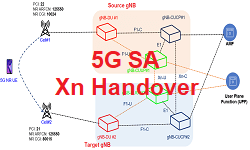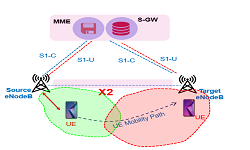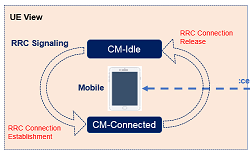5G SA Inter gNB Handover | 5G NGAP Handover
Introduction
Mobility (Handover) in an important feature in any telecom generation and so it is in 5G. The basic handover procedure remains same as it was in legacy networks, i.e. UE reports measurement report with neighbor cell PCI and signal strength to source cell, source cell take the decision to start handover procedure to best target cell and Target Cell completes the Handover procedure.
In LTE, we use to have different types of Intra System (LTE to LTE) handover like X2 Based Handover, S1 Based Handover, Inter Frequency, Intra Frequency and Inter sector handovers, similarly 3GPP specification has defined different Intra system (5G NR to 5G NR) handovers, e.g. Xn based Handover, N2 or NGAP Based Handover, Intra and Inter Frequency Handovers.
In this post we will discuss about Inter gNB N2 or NGAP Handover, When the UE moves from one gNB to another gNB without relolcating the AMF and UPF.
Key Pointers for N2 Handover
- 5G N2 Handover is similar S1 Handover in 4G
- N2 Handover does not depend on availability of Xn Interface
- If two gNB having Xn interface still does go for N2 Handover given that XnHO is not permitted within configuration
- This type of Handover can applicable for intra-AMF mobility or Inter AMF Mobility, i.e. Source and Target gNB can be connected to same AMF or different AMF
- N2 Handover can be Intra Frequency HO and Inter Frequency HO
- Source and Target gNB can be connected two different UPFs
- Re-Registration is required after Successful Handover if the Source gNB and Target gNB belong to different Tracking Area (TAC)
- N2/NGAP Handover take more time than Xn HO as 5G Core is involved all signalling only
- N2 Handover can support Direct Data Forwarding or Indirect Data Forwading
N2 Handover Procedure

Above picture depicts the mobility scenarios where UEs is connected to cource cell with PCI: 22 with gNB#1 and it is moving toward target cell#2 with PCI:21 with gNB#2. In this handover procedure the signaling will involve messaging over N2 interface using using NGAP protocol.
N2 Handover Call Flow
The Call flow for N2 or NGAP Handover for Inter gNB 5G SA deployment is shown as below. To avoid complexity for the call flow, we considered gNB-DU, gNB-CUCP and gNB-CUCP as a single entity as gNB and not including internal DU, CUCP and CUUP signaling.
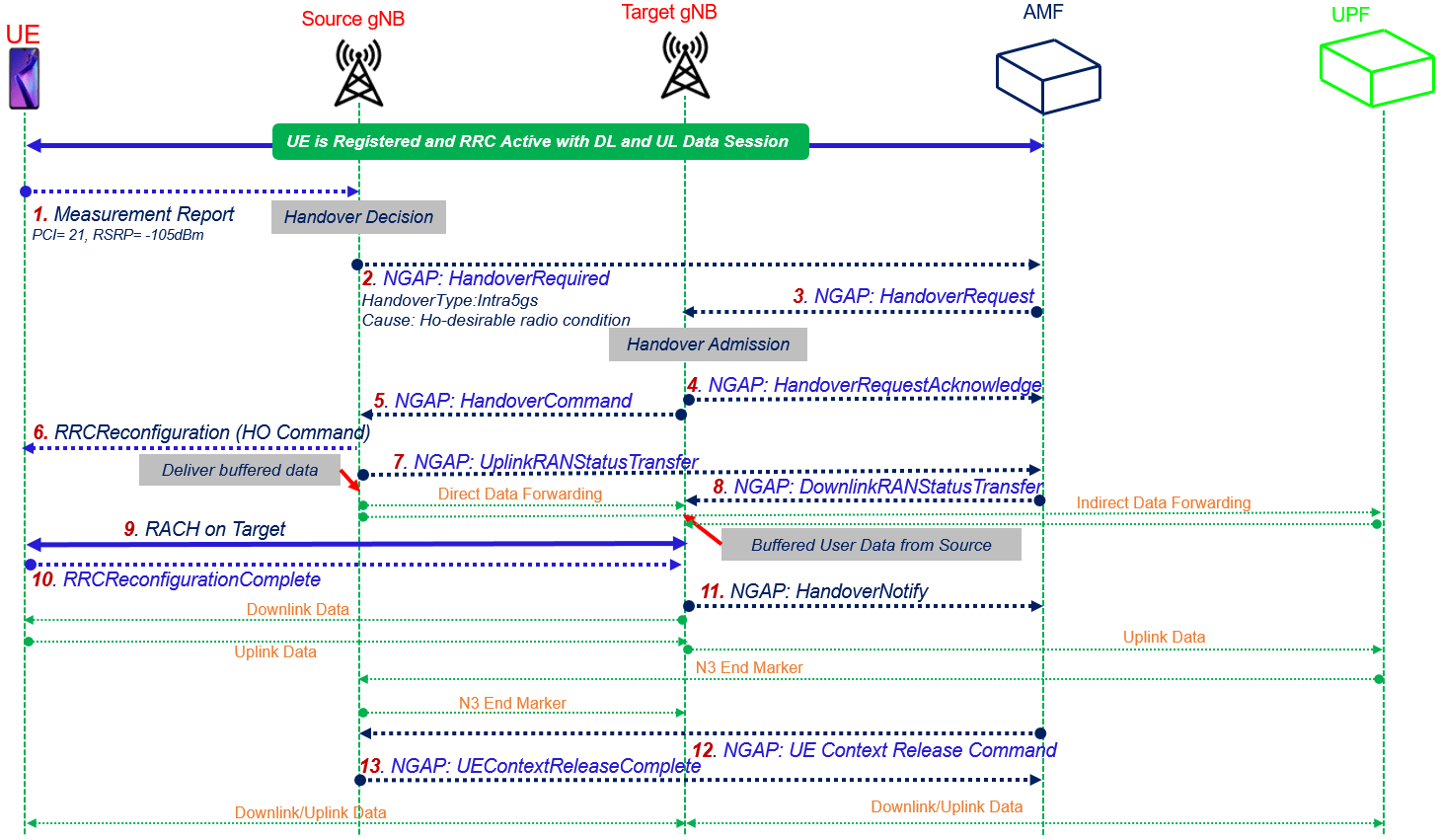
- Step#0: UE is in RRC_CONNECTED, sending and receiving uplink and downlink data at the source gNB and moving toward the Target gNB
- Step#1-MeasurementReport: The UE sends a MeasurementReport message to the source gNB#1 including the serving cell and neighboring cell signal strength.
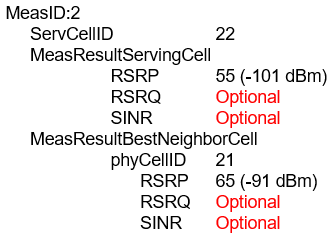
- Step#1.1: Based on the measurement report and other information e.g. cell load and taking into account UE mobility restrictions and radio capabilities, the source gNB decides to hand over the UE and selects the target gNB for handover.
- Step#2-Handover Required: Based on source gNB HO decision it trigger an N2 handover and sends an N2 Handover Required message to AMF. The message contains the UE RAN-NGAP-ID, AMF-NGAP-ID, Target gNB ID, Handover Type, Handover Cause and also information about the PDU Sessions to be handed over.
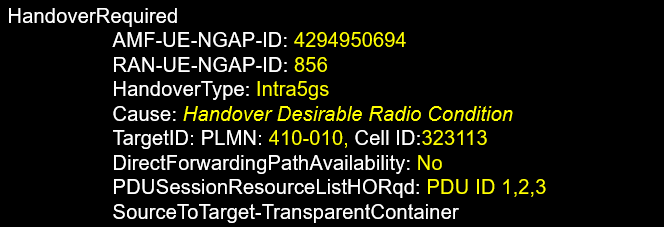
- Step#3-HandoverRequest: Once AMF recieve the Handover Required, it identify the Target gNB from it and send Handover Request inclduing UE Security context, UE capabilities, PDU Session Information, Source to Target Transparent Containter, GUAMI etc.
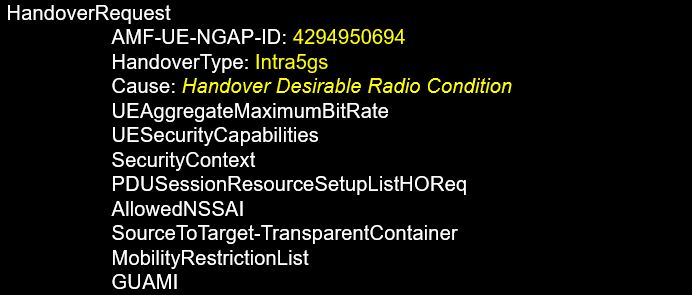
- Step#4-HandoverRequestAcknowledge: After recieving the Handover Request from AMF, the target gNB can make a decision to admit UE or not based on the resources available. If target gNB is able to admit all the PDU session with respective data bearers, it can respond to AMF with HandoverRequestAcknowledge. HandoverRequestAcknowledge message includes UE-NGAP-IDs, list of admitted PDU Sessions, and TargetToSource-TransparentContainer.

- Step#5-HandoverCommand: AMF sends a Handover Command to source gNB. This message includes, information received in step#4 . The source gNB can now send a Handover Command to the UE in step#6. After receiving the Handover Command, the UE will leave the source cell and start the connection towards the target cell.

- Step#6-RRCReconfiguration: The source gNB triggers the handover by sending the RRCReconfiguration message to the UE, containing the information required to access the target cell received in step#5 at least the target cell ID, the new C-RNTI, and the target gNB security algorithm identifiers for the selected security algorithms.
- Step#7-UplinkRANStatusTransfer: After Sending the Handover command over air interface source gNB send UplinkRANStatusTransfer to AMF including UE-NGAP-IDs for both RAN and AMF and RANStatusTransfer-TransparentContainer. RANStatusTransfer-TransparentContainer have information about all DRBs PDCP SN served at source gNB.

- Step#8-DownlinkRANStatusTransfer: AMF transfers the received UplinkRANStatusTransfer informration to Target gNB using DownlinkRANStatusTransfer message.

- Step#9–RACH on Target: A Random Access procedure is performed at the target gNB, considering the information recieved in step#6 as part of rach-ConfigDedicated
- Step#10-RRCReconfigurationComplete: After the UE has successfully connected to the target cell, it completes the handover procedure by sending the RRCReconfigurationComplete message to target gNB. UE starts Uplink data to Target gNB.
- Step#11-HandoverNotify: The target gNB then sends a Handover Notify to AMF, and by this the target gNB considers the handover successful. This message include UE-NGAP-IDs for both RAN and AMF to identify the UE context and also UE location information mean under which Tracking Area (TAC) UE is being served.

- Step#12-UEContextReleaseCommand: By sending UEContextReleaseCommand AMF will instruct source gNB to release the resources related to this UE. AMF in the message includes UE-NGAP-IDs to identify the UE context and cause indicating successful handover

- Step#13-UEContextReleaseComplete: Source gNB sends UEConextReleaseComplete upon successful deleting the UE context and release all the associated resource for the UE.

In some cases, the UE needs to initiate a Mobility Registration procedure after the handover is completed, e.g., if the handover resulted in that the UE moved outside its Registration Area.
References:
- 3GPP TS 38 300- 5G NR Overall description Stage-2
- 3GPP TS 38.401 – 5G NG-RAN Architecture Description
- 3GPP TS 38.412 – 5G NG-RAN NG signalling transport
Related Posts:
- 5G Standalone Mode Registration-Attach Call Flow
- 5G RAN and 5GC Network Slice Signaling
- 5G NR HO Setup: Handover Testing in Cabled Setup
- 5G SA Xn Handover Call flow

